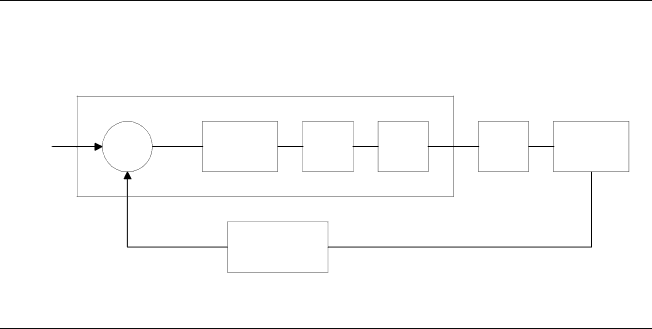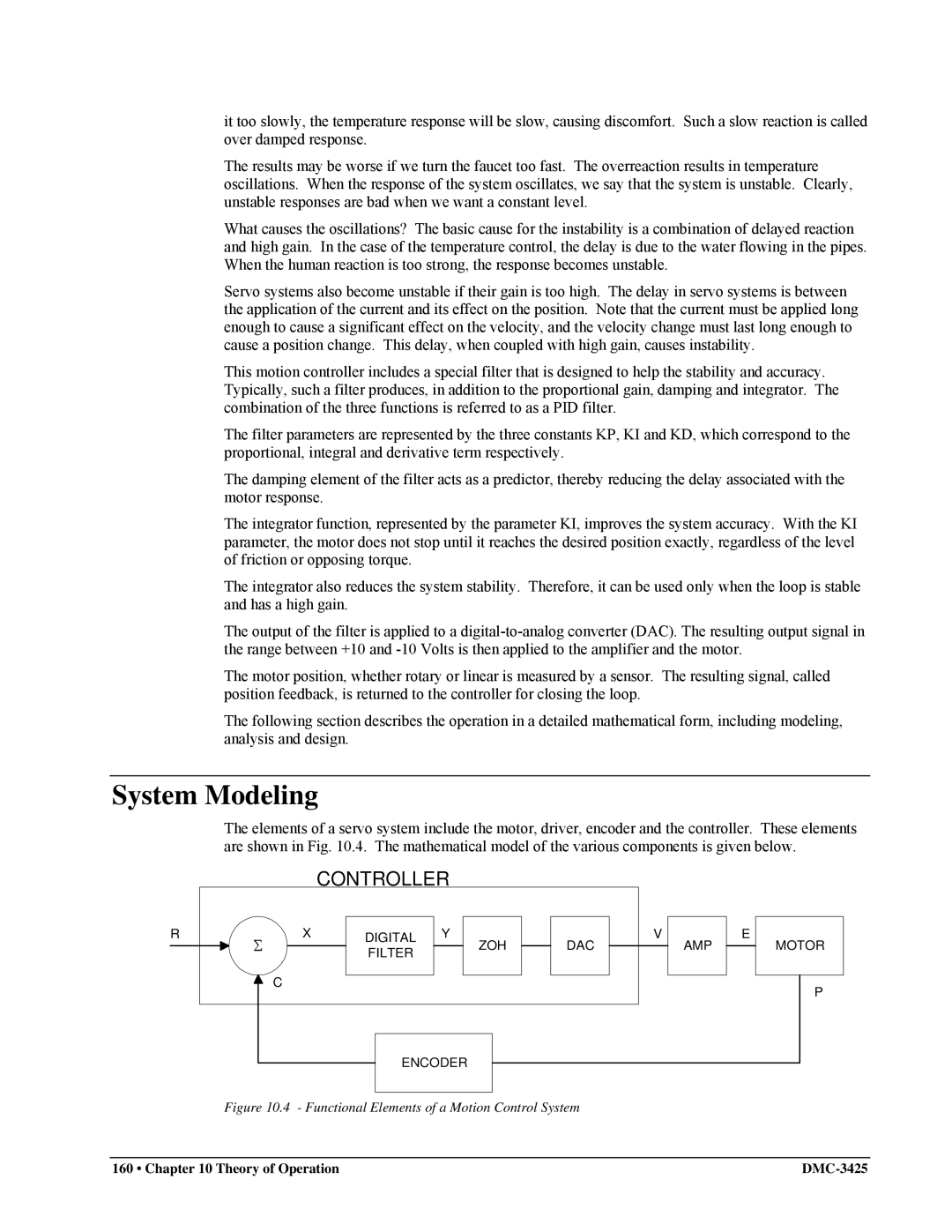DMC-3425
By Galil Motion Control, Inc
Page
Contents
Connecting Hardware
Programming Motion
Application Programming 107
DAC
ZOH
J5 Power 6 PIN Molex
Warranty
Overview
Introduction
Standard Servo Motors with +/- 10 Volt Command Signal
Stepper Motor with Step and Direction Signals
Overview of Motor Types
Brushless Servo Motor with Sinusoidal Commutation
DMC-3425 Overview
DMC-3425 Functional Elements
Microcomputer Section
Motor Interface
Communication
General I/O
System Elements
Motor
Amplifier Driver
Watch Dog Timer
Encoder
Getting Started
DMC-3425 Motion Controller
Installing the DMC-3425 Controller
Elements You Need
Determine Overall Motor Configuration
Configuring Jumpers on the DMC-3425
Setting the Baud Rate on the DMC-3425
Selecting MO as default on the DMC-3425
Stepper Motor Jumpers
9600 1200
Axis Configuration Jumpers
A1 A2 A4 A8
Installing the Communications Software
Using Galil Software for DOS
Using Galil Software for Windows
Getting Started DMC-3425
Using Non-Galil Communication Software
Sending Test Commands to the Terminal
Communicating through the Ethernet
TPA CR
Address
Set-up axis for sinusoidal commutation optional
Make connections to amplifier and encoder
Getting Started DMC-3425
Connect Standard Servo Motor
Check the Polarity of the Feedback Loop
MO CR
Inverting the Loop Polarity
SH CR
BG CR
TT CR
Power Supply
Connect brushless motor for sinusoidal commutation
If Hall Sensors are Available
If Hall Sensors are Not Available
Connect Step Motors
BGA CR
Amacr
BC CR
Tune the Servo System
TE CR
Configure the Distributed Control System
Configuring Operation for Distributed Control
Automatic Configuration of Distributed Control
Manual Slave IP configuration with HC command
Manual Configuration of Distributed Control
#SETUP
Mgconfiguration Failed Else Mgconfig Success Endif
Instruction Interpretation
NA6
CHC=D,E
CHE=F,G
Design Examples
Example 1 System Set-up
Example 2 Profiled Move
Example 3 Position Interrogation
Example 8 Operation in the Buffer Mode
Example 5 Velocity Control Jogging
Example 6 Operation Under Torque Limit
Example 7 Interrogation
Example 9 Motion Programs
Example 10 Motion Programs with Loops
Example 11- Motion Programs with Trippoints
Example 12 Control Variables
Example 13 Control Variables and Offset
Return to top of program
Using Inputs
Limit Switch Input
Overview
Home Switch Input
Abort Input
Amplifier Interface
Uncommitted Digital Inputs
TTL Inputs
Analog Inputs
TTL Outputs
This page Left Blank Intentionally
RS-232 Configuration
RS232 Port
RS232 Port 1 Dataterm
Baud Rate Selection
Ethernet Configuration
Communication Protocols
Addressing
Handshaking Modes
Ethernet Handles
Global vs. Local Operation
Local Operation
Accessing the I/O of the Slaves
Operation of Distributed Control
Handling Communication Errors
Multicasting
Digital Outputs
Digital Inputs
Unsolicited Message Handling
IOC-7007 Support
Modbus Support
Function Code Definition
Handle Switching
Handle Restore on Communication Failure
Other Communication Options
User Defined Ethernet Variables
Data Record
Data Record Map
Waiting on Handle Responses
DMC-3425 Communication
Communication DMC-3425
Axis Switch Information 1 Byte
Header Information Byte 0, 1 of Header
Bytes 2, 3 of Header
General Status Information 1 Byte
QZ Command
Axis Status Information 2 Byte
Coordinated Motion Status Information for plane 2 Byte
Using Third Party Software
This page Left Blank Intentionally
Command Syntax Ascii
Important All DMC-3425 commands are sent in upper case
Command Syntax Binary
Coordinated Motion with more than 1 axis
Binary Command Format
Byte
Header Format
Binary command table
Datafields Format
Example
LE, VE
Controller Response to Data
Interrogation Commands
Summary of Interrogation Commands
Interrogating Current Commanded Values
Interrogating the Controller
Command Summary
This page Left Blank Intentionally
Programming Motion
Mode of Motion Basic description Commands Global
Independent Axis Positioning
VP, CR
Command Summary Independent Axis
Operand Summary Independent Axis
Examples
Absolute Position Movement
InstructionInterpretation
BG C
Command Summary Jogging
Independent Jogging
Jog in a and C axes
Linear Interpolation Mode Local Mode
Specifying Linear Segments
Joystick Jogging
Additional Commands
Specifying Vector Speed for Each Segment
#ALT
Lmab
Command Summary Linear Interpolation
Operand Summary Linear Interpolation
Changing Feedrate
BGS
Example
Example Linear Move
Linear Interpolation Motion
#LMOVE
Example Multiple Moves
#LOAD
Vector Mode Linear and Circular Interpolation Local Mode
Specifying Vector Segments
Additional commands
Command Summary Coordinated Motion Sequence
Compensating for Differences in Encoder Resolution
Operand Summary Coordinated Motion Sequence
Trippoints
VM AB
Required Path
Electronic Gearing Local Mode
Command Summary Electronic Gearing
Example Gantry Mode
Example Electronic Gearing
Electronic Cam Local Mode
GA, CA
BGB
GA,A
Programming Motion DMC-3425
DMC-3425 Programming Motion
3000 2250 1500 2000 4000 6000 Master
EAA
#LOOP
#RUN
EB1
#LOOPJP#LOOP,V1=0
ST a
Contour Mode Local Mode
Specifying Contour Segments
Instruction Description
CMA
DT0CD0
Command Summary Contour Mode
Operand Summary Contour Mode
General Velocity Profiles
Generating an Array An Example
Contour Mode Example
#POINTS
POSC=V4
Teach Record and Play-Back
Record and Playback Example
Virtual Axis Local Mode
Mode of Motion Virtual Axis usage Commands
Stepper Motor Operation
Ecam Master Example
Sinusoidal Motion Example
Specifying Stepper Motor Operation
Monitoring Generated Pulses vs. Commanded Pulses
Stepper Motor Smoothing
Using an Encoder with Stepper Motors
Command Summary Stepper Motor Operation
Motion Complete Trippoint
Operand Summary Stepper Motor Operation
Using the CE Command
Additional Commands for the Auxiliary Encoder
Dual Loop Auxiliary Encoder
Backlash Compensation
Continuous Dual Loop
Sampled Dual Loop
#DUALOOP
DE0
Using the IT and VT Commands
Motion Smoothing
JP#CORRECT
#END
Homing
Trapezoidal velocity and smooth velocity profiles
#HOME
HM a
AM a
MG AT Home
Home Switch
Command Summary Homing Operation
High Speed Position Capture Latch
Operand Summary Homing Operation
Input Function
AL B
This page Left Blank Intentionally
Application Programming
Global vs. Local Programming
Edit Mode Commands
Entering Programs
Return
ED #BEGIN
Using Labels in Programs
Program Format
Valid labels
Invalid labels
No Command and the Apostrophe ‘
Special Labels
Commenting Programs
REM Command
Executing Programs Multitasking
Debugging Programs
Trace Command
Error Code Command
Stop Code Command
RAM Memory Interrogation Commands
Breakpoints and single stepping
Eeprom Memory Interrogation Operands
Program Flow Commands
Event Triggers & Trippoints
DMC-3425 Event Triggers
Example- Multiple Move Sequence
AS a B C D E F G H
Example- Set Output after Distance
Example- Repetitive Position Trigger
Example Start Motion on Input
Example Set Output when At Speed
Example Change Speed along Vector Path
Example Multiple Move with Wait
Example- Define Output Waveform Using AT
Command Format JP and JS
Conditional Jumps
Format
Example using variables named V1, V2, V3
Logical operators
Conditional Statements
Multiple Conditional Statements
Using the if and Endif Commands
If, Else, and Endif
Examples
Using the Else Command
Command Format IF, Else and Endif
Nesting if Conditional Statements
Format Description
Auto-Start and Auto Error Routine
Subroutines
Stack Manipulation
Example Limit Switch
Example Position Error
Automatic Subroutines for Monitoring Conditions
Example Motion Complete Timeout
Example Command Error
Example Input Interrupt
Example Command Error w/Multitasking
Example Ethernet Communication Error
Mathematical and Functional Expressions
Mathematical Operators
Operator Function
Bit-Wise Operators
ENTER,LENS6
FLEN=@FRACLEN
LEN1=FLEN&$00FF
Variables
Functions
POS
PR Posa
Programmable Variables
Assigning Values to Variables
Assigning Variable Values to Controller Parameters
Displaying the value of variables at the terminal
Example Using Variables for Joystick
Operands
Special Operands
Instruction
Arrays
Defining Arrays
Assignment of Array Entries
Using a Variable to Address Array Elements
Uploading and Downloading Arrays to On Board Memory
Automatic Data Capture into Arrays
Command Summary Automatic Data Capture
Data Types for Recording
Operand Summary Automatic Data Capture
Example Recording into An Array
Outputting Numbers and Strings
Deallocating Array Space
Sending Messages
Specifying the Port for Messages
Using the MG Command to Configure Terminals
Formatting Messages
MG STR S3
Displaying Variables and Arrays
Summary of Message Functions
Example Printing a Variable and an Array element
Function Description
Local Formatting of Response of Interrogation Commands
LZ0
LZ1
Formatting Variables and Array Elements
Local Formatting of Variables
VF1
V1=ALPHA
Hardware I/O
Converting to User Units
Digital Outputs
Example- Set Bit and Clear Bit
Example Using Inputs to control program flow
Example Start Motion on Switch
Digital Inputs
Example- Output Port
Input Interrupt Function
Analog Inputs
Example Position Follower Point-to-Point
Configuring the I/O of the DMC-3425
Extended I/O of the DMC-3425 Controller
Example Position Follower Continuous Move
Accessing Extended I/O
Saving the State of the Outputs in Non-Volatile Memory
Bit I/O Block Binary Representation Decimal Value for
Wire Cutter
Example Applications
Interfacing to Grayhill or OPTO-22 G4PB24
Argument Blocks Bits Description
X-Y Table Controller
JP #A
BGC
AMC
BGC AMC
Speed Control by Joystick
BGS AMS
Position Control by Joystick
JG VEL JP #B
This page Left Blank Intentionally
Hardware Protection
Output Protection Lines
Signal or Function State if Error Occurs
Software Protection
Input Protection Lines
Programmable Position Limits
Off-On-Error
Automatic Error Routine
#AJP #AEN
Limit Switch Routine
Limit Switch Example
Installation
Symptom Cause Remedy
Symptom Cause
Communication
Stability
Operation
Theory of Operation
Level
Operation of Closed-Loop Systems
Velocity and Position Profiles
System Modeling
Functional Elements of a Motion Control System
Motor-Amplifier
Voltage Drive
Current Drive
Velocity Loop
Elements of velocity loops
Voltage Source
DAC
Digital Filter
System Analysis
ZOH
Motor Ms = P/I = Kt/Js2 = 500/s2 rad/A Amp Ka = 4 Amp/V
System Design and Compensation
Analytical Method
Kd = 10/32768 = Encoder Kf = 4N/2π =
DMC-3425 Theory of Operation
Equivalent Filter Form
KP, KD, KI, PL
PID, T
Electrical Specifications
Performance Specifications
Power Requirements
Servo Control
Connectors for DMC-3425
J3 DMC-3425 General I/O 37- PIN D-type
Acmda Pwma
Acmdy Signa
J3 DMC-3425-Stepper General I/O 37- PIN D-type
Pwmb
Signb Pwma
Signa
Pin-Out Description
J1 RS232 Main port DB-9 Pin Male
DCD DTR GND DSR RTS CTS
RTS CTS GND
Features
Specifications
ICM-1460 Interconnect Module
Reset
ERROR/PULSEY
AMPEN/SIGNY5
ACMDX/PULSEX
Opto-Isolation Option for ICM-1460
Opto-isolated inputs
Opto-isolated outputs
Figure A-1
Configuring the I/O of the DMC-3425 with DB-14064
CO n
Accessing extended I/O
Saving the State of the Outputs in Non-Volatile Memory
Connector Description
J6 50-PIN IDC Pin Signal Block Bit @INn Bit No @OUTn
Block Bit @INn Bit No @OUTn
IOM-1964 Opto-Isolation Module for Extended I/O Controllers
Description
Overview
Buffer chips
Configuring Hardware Banks
Figure A-4
Input Circuit
High Power Digital Outputs
Figure A-6
Output Command Result
Standard Digital Outputs
Electrical Specifications
High Power Digital Outputs
Standard Digital Outputs
Relevant DMC Commands
Screw Terminal Listing
DMC-3425 Appendices
PWROUT32
PWROUT31
PWROUT30
PWROUT29
Coordinated Motion Mathematical Analysis
1000 2000
Velocity
100000 = 0.05 s 2000000
List of Other Publications
Training Seminars
WHO should Attend
Contacting Us
Galil Motion Control
Warranty
Index
Eeprom
Homing, 38
Eeprom
Index DMC-3425

